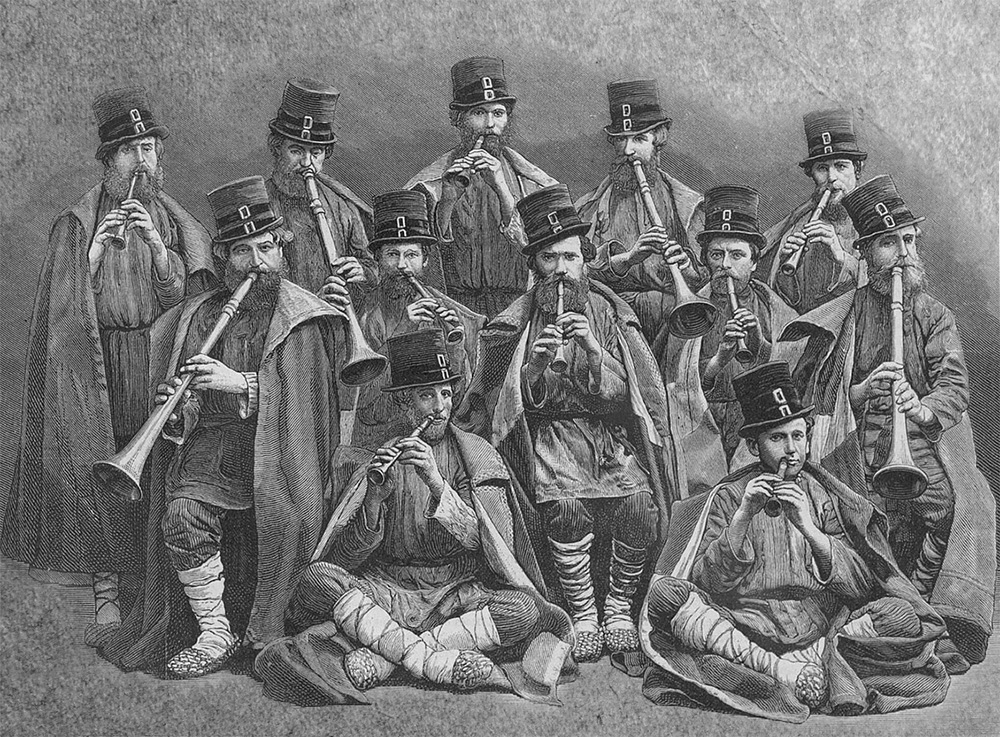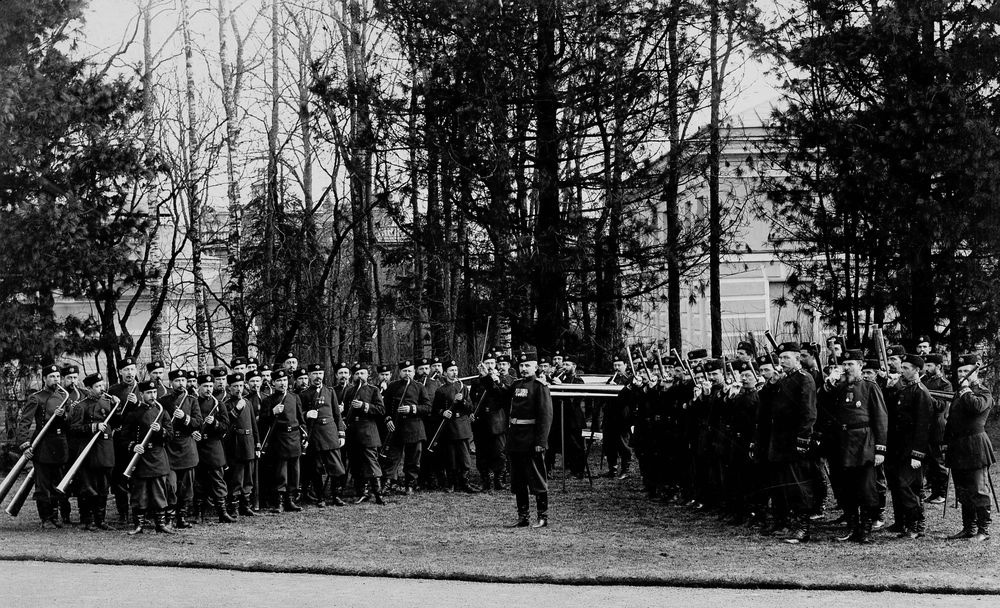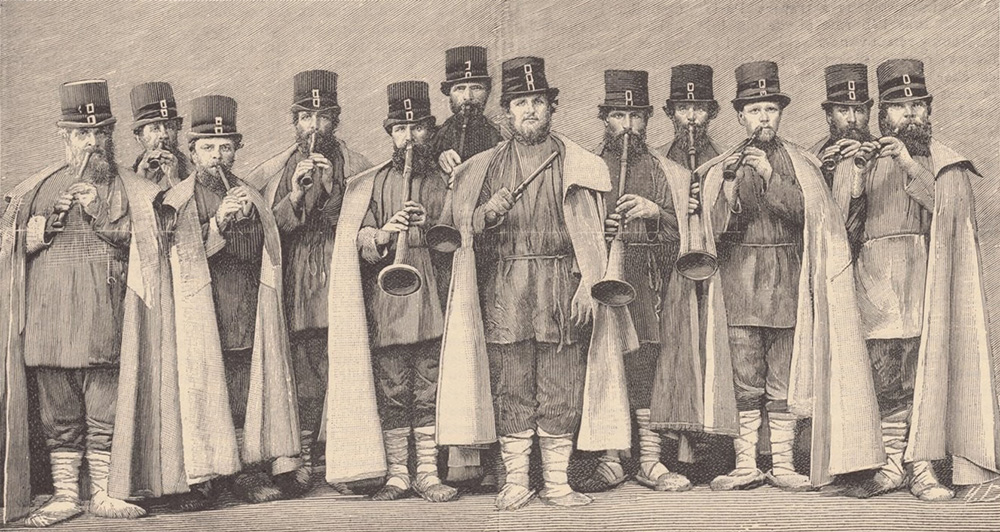Horn players choir of N.V. Kondratyev

The horn musicians of the Vladimir province became especially popular in the last quarter of the 19th century. In fact, a whole trade of Vladimir shepherds-horn players was formed. They went to work in other provinces and were indispensable participants in village festivals, and also performed at city fairs.
In the late 1860s — early 1870s, a peasant Nikolay Vasilyevich Kondratyev (1843-1937) created a choir of horn players in the village of Mishnevo, Kovrov district (now Kameshkovo district). At the age of ten, Kolya Kondratyev became a shepherd boy and started learning to play the horn. Possessing excellent hearing, he learned a lot from experienced Mishnevo horn players, who were famous throughout the district. Even recognized masters began to admire his performance soon.

An excellent organizer and talented musician with an inexhaustible stock of songs, Nikolay Kondratyev assembled an ensemble consisting of 12 horn players from different villages – Mishnevo, Suslovo, Gorki, Berkovo, Ostrov, Mashkovo, Kamenevo, Simakovo. These illiterate people were good at instruments (8 played the «screechers» horns and 4 – the bass), sang melodies from memory and improvised freely. The first performances of the choir of horn players took place mainly at festivals and festivities in neighboring provinces.
There are very few documents that tell about the concert activities of the Kondratyev’s choir. However, it is known that it performed in more than 40 cities in Russia and even in other countries. The turning point in the creative activity of the horn players was 1883, when they were invited to play during the festivities on the Khodynskoye field in Moscow on the occasion of the coronation of Alexander III and made a sensation. In June 1883, peasant musicians already performed in St. Petersburg, being perceived by the discerning metropolitan audience as a new interesting phenomenon of folk music-making. They were financed by entrepreneur A.F. Kartavov for this trip, who played a significant role in the further fate of the choir. After the performance in the garden «Livadia», which belonged to Kartavov, the fame of the Kondratyev’s horn players also reached the imperial court. They were invited to Peterhof and had the honor to play for Alexander III and his family. The emperor's interest in horn players was not accidental: he had a passion for wind instruments, played the French horn and cornet himself, and in 1882 created the first in Europe brass orchestra at court – the «Court Musician Choir». However, according to the recollections of peasant musicians, the emperor could not make a single clear sound on the horn, only hiss. The horn turned out to be a difficult instrument for Alexander III, but he praised the musicians and thanked them with money.

In 1889, the Vladimir horn players performed at the World Industrial Exhibition in Paris. N. Kondratyev's choir was again invited to Paris in the spring of 1892, but already on a two-month concert tour. A historical photo in a French magazine remained: 12 bearded men in top hats, wide robes and bast shoes press shepherd's horns to their lips. The horn players had to demonstrate calluses on their hands, proving to the enthusiastic audience that they were not dressed up artists from the conservatory, but real peasants. But the Paris tour ended sadly: the entrepreneur Kartavov squandered the money earned by the horn players and escaped, leaving his wards penniless. Abandoned in a foreign land without knowledge of foreign languages, Russian peasant musicians earned food by rare performances and even alms. They walked all over Europe on foot, returning to their homes, though beggarly, but not broken. The artistic description of the adventures of the Kondratyev’s choir in Paris is embodied in the story «The Miraculous Horn» by the Vladimir writer S.K. Nikitin.

In 1896, the Vladimir horn players performed at the All-Russian Industrial and Art Exhibition in Nizhny Novgorod with great success, which was noted in the press. At that time, the novice writer Maxim Gorky drew attention to their art and the faithful transmission of the tunes of Russian songs.
In 1902, the creativity of Kondratyev’s horn players won the hearts of the visitors of the All-Russian handicraft exhibition in St. Petersburg. N.V. Kondratyev ended his career as a choir director with this performance at the handicraft exhibition. By this time, the famous folk musician was in his sixtieth year. Permanent touring from city to city became difficult for him, in addition, his teeth fell out, which was a real tragedy for a horn player. With his direct participation, the choir existed for almost thirty years. Its repertoire included over 200 tunes and songs. Kondratyev entrusted the leadership of the choir to his most talented disciple and colleague – P.G. Bakharev (Pakharev), who was seventeen years younger than him.
Russian musician and founder of the first orchestra of Russian folk instruments in history – V.V. Andreev, having become acquainted with the art of the Vladimir horn players, suggested N.V. Kondratyev to introduce horns into his Great Russian Orchestra. He appreciated the Kondratyev choir as an extremely rare phenomenon, an example of truly folk instrumental music, with its own rules and laws, which are of particular interest.
In 1902, the collector of folk songs E.E. Lineva recorded «Kamarinskaya» performed by the choir of N.V. Kondratyev to the phonograph. Thanks to her, we are able now to hear a unique ensemble of horn players, although the recording itself is imperfect. E.E. Lineva confirmed the opinion of her predecessors, folklorists, about the closeness of the composition and timbre of the «song orchestra» (as she called the ensemble of Vladimir horn players) to folk choral performance.